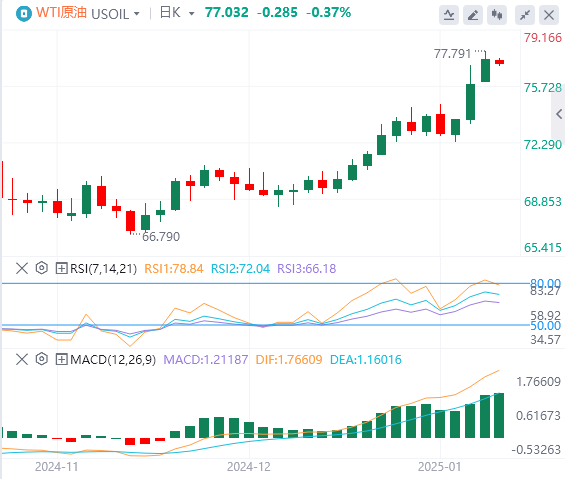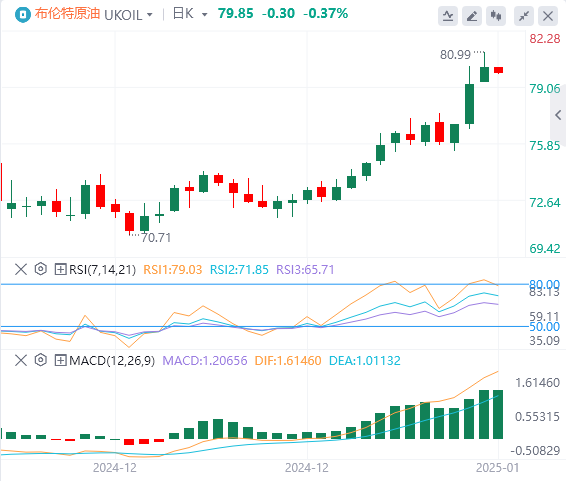As US sanctions on Russian oil threaten to tighten global supply, WTI prices have climbed to their highest level since October 8. As of now, WTI crude oil is quoted at $77.03 and Brent crude oil is quoted at $79.85.


New York Fed survey: 1-year inflation expectations are 3%, interest rate futures traders price in less than 25 basis points of interest rate cuts by the Fed this year, or less than one time.
Foreign media said that Trump's team is studying the possibility of increasing tariffs by 2%-5% every month, but Trump himself has not yet evaluated or approved the idea of gradual tariffs.
Sources revealed that the ceasefire negotiations in Gaza have made a breakthrough, and Qatar has submitted the "final" draft of the agreement to Israel and Hamas. Hamas officials also said that they are "very close" to reaching a ceasefire agreement with Israel; US President's National Security Advisor Sullivan believes that it is possible to reach an agreement on the Gaza region this week.
Six EU countries called for a reduction in the G7's price ceiling for Russian oil.
US crude oil futures may retest the resistance level of $79.04 per barrel, and a break above this price may open the way to the $80.10 to $80.75 range.
The contract is on wave C, which could extend to the 261.8% level at $80.10. Resistance at $79.04 has temporarily stopped the price from rising.
However, there is no convincing top signal near $79.04. The key level to watch closely is $77.34, which, if broken, could indicate that the C wave is complete. A short target area of $75.64 to $76.29 would then be established.
On the daily chart, two long white candles on January 10 and January 13 represent strong bullish momentum, which could push the price above the strong resistance level of $79.80.
Channel technology shows a target of $84.84, which will become a realistic target when the market breaks through $79.80.
Oil prices rose after the United States announced tougher sanctions on Russian oil. On the surface, these sanctions could have a significant impact on Russian oil flows. We have already seen disruptions to Russian (and Iranian) exports before these sanctions. The physical market in the Middle East has been strong as buyers look for alternative grades of crude oil. It is estimated that Russia's shadow fleet transports a little over 80% of Russia's seaborne crude oil exports. While the true size of the shadow fleet is unknown, it is estimated that it may be as many as 600 tankers. S&P Global estimates the size of the tanker fleet at 586 ships, which means that about 25% of the shadow fleet is subject to sanctions. This could put about 700,000 barrels per day of Russian crude oil at risk. Losing this amount would wipe out the surplus we expect in the global oil market this year.
However, the actual amount lost may be smaller. Some buyers may choose to ignore these sanctions, and Russia may also rely more on non-sanctioned tankers in the shadow fleet to continue trading. Over time, Russia may have to increase the size of its fleet to allow flows to continue uninterrupted. In addition, if sanctions cause major buyers to withdraw, the spread for Russian crude oil may fall. If the logistics of transporting Russian crude oil encounter bottlenecks, we may see more Western shipping and insurance services used for Russian oil, which means that the price of Russian oil must be below the $60/bbl cap set by the G7.
We think the uncertainty of how much impact these sanctions will have is good for the oil market. Obviously, if the loss volume reaches around 700,000 barrels/day, we will need to revise our current forecast of $71/bbl for Brent crude oil in 2025. However, as we have seen after the EU banned Russian oil and product imports, Russia successfully changed trade flows, which means that the actual impact on Russian export volumes may not be significant. It is possible that Russia will take action again to minimize the impact of these sanctions. In addition, it is not clear whether the incoming Trump will continue these sanctions or whether they will be strictly enforced.
Sanctions are clearly being implemented more stringently. According to the data, Russian seaborne crude oil exports fell to just below 2.9 million bpd in the week ending January 5. Meanwhile, the less volatile four-week average also fell to just above 2.9 million bpd, the lowest level since August 2023. Export disruptions occurred mainly in Russia's Baltic ports. The shipping route through the Baltic Sea is more risky for the Russian shadow fleet because tankers here are easier to inspect. Exports through Black Sea and Pacific ports have remained largely stable, except for the usual weather fluctuations. Therefore, crude oil may also be diverted to ports in the Black Sea or Pacific to load there.
However, Russia is processing more crude oil, but less crude oil is entering the market, which has led to supply shortages in countries such as India. According to reports, Indian state-owned refineries have lost 10-15 cargoes of Russian crude oil that were scheduled to load in January. As a result, India has had to look for alternative suppliers, mainly in the Middle East, which has created additional demand and led to a tightening market. Supply disruptions have pushed oil prices close to their highest level since October 2024.
The question now is how high can oil prices go? This month, both the EIA and IEA are likely to revise down their forecasts for crude oil demand growth this year in their latest reports. While we don’t expect any major revisions, as the forecasts are already somewhat pessimistic, the IEA forecast revision is unlikely to provide much of a boost. And OPEC is likely to cut its demand forecast again, bringing it closer to the IEA forecast. With such a pessimistic demand scenario, it’s hard for oil prices to continue to rise. Some adjustments may be seen this week.
The new energy sanctions imposed by the US government on Russia last Friday were the main driver of the rise in oil prices, but we believe this is actually the result of a long-term decline in crude oil inventories. And the time spread has been tightening. Given that the new sanctions are CAATSA (Countering America’s Adversaries Through Sanctions Act), it will be more difficult for Trump to revoke them, and it will take at least a month of congressional review process to change them. However, he can use these sanctions as a bargaining chip in the negotiations on the Russian-Ukrainian conflict.
At the same time, Trump may impose new sanctions on Iran and Venezuela to make room for more US crude oil. Therefore, as he takes office, new sanctions may develop in this direction, and higher oil prices may also be necessary. More importantly, the US shale oil industry may need to see that the global market needs an additional 3 million barrels per day of crude oil sustainably in the next 3-4 years, not just in the short term.
We believe that the new sanctions are eliminating the last loopholes in the existing US sanctions program against Russia, and this process may take several months. If the origin crude oil price is $60/barrel or lower and the oil saturation level is comparable, Russia can still export crude oil and refined oil through Western tankers. However, the new sanctions will definitely reduce the export level of Russian crude oil, pushing Asian buyers to turn their attention to the Middle East. This expectation also continues to widen the 1-3 month price gap between Brent crude oil and Dubai crude oil.
This spread has now widened to $2/bbl, consistent with Brent trading in the $80-90 range. But Brent is also in a solid overbought zone, so a pullback may be in the cards before Brent can sustainably trade in the $80-90 range. Technically, Brent is well above its 200-day moving average of $78.98. It is worth noting that since the beginning of 2023, Brent has typically stayed above this average for 1-3 months.
The question now is, how high can oil prices go? This month, both the EIA and IEA are likely to revise down their forecasts for crude oil demand growth this year in their latest reports. While we don’t expect any major revisions, as the forecasts are already somewhat pessimistic, the IEA forecast revision is unlikely to provide much of a boost. And OPEC is likely to revise down its demand forecast again, bringing it closer to the IEA forecast. It will be hard for oil prices to continue to rise under such a pessimistic demand scenario. Some adjustments may occur this week.
The new energy sanctions imposed by the US government on Russia last Friday were the main driver of the rise in oil prices, but we believe that this is actually the result of a long-term decline in crude oil inventories. And the time spread has been tightening. Considering that the new sanctions are CAATSA (Countering America's Adversaries Through Sanctions Act), it will be more difficult for Trump to revoke these sanctions, and it will take at least a month of congressional review process to change them. However, he can use these sanctions as a bargaining chip in the negotiations on the Russia-Ukraine conflict.
At the same time, Trump may impose new sanctions on Iran and Venezuela to make room for more US crude oil. Therefore, as he takes office, new sanctions may develop in this direction, and higher oil prices may also be necessary. More importantly, the US shale oil industry may need to see that the global market needs an additional 3 million barrels/day of crude oil sustainably in the next 3-4 years, not just in the short term.
We believe that the new sanctions are closing the last loopholes in the existing US sanctions program against Russia, a process that could take months. Russia can still export crude oil and refined products via Western tankers if the origin crude oil price is $60/bbl or lower and the oil saturation level is comparable. However, the new sanctions will certainly reduce the export level of Russian crude oil, pushing Asian buyers to turn their attention to the Middle East. This expectation also continues to widen the 1-3 month spread between Brent and Dubai crude oil.
The spread has now widened to $2/bbl, consistent with Brent trading in the $80-90 range. But Brent is also in a solid overbought zone, so it may experience a retracement before Brent can sustainably trade in the $80-90 range. Technically, Brent is well above its 200-day moving average of $78.98. It is worth noting that since the beginning of 2023, Brent has usually remained above this average for 1-3 months.